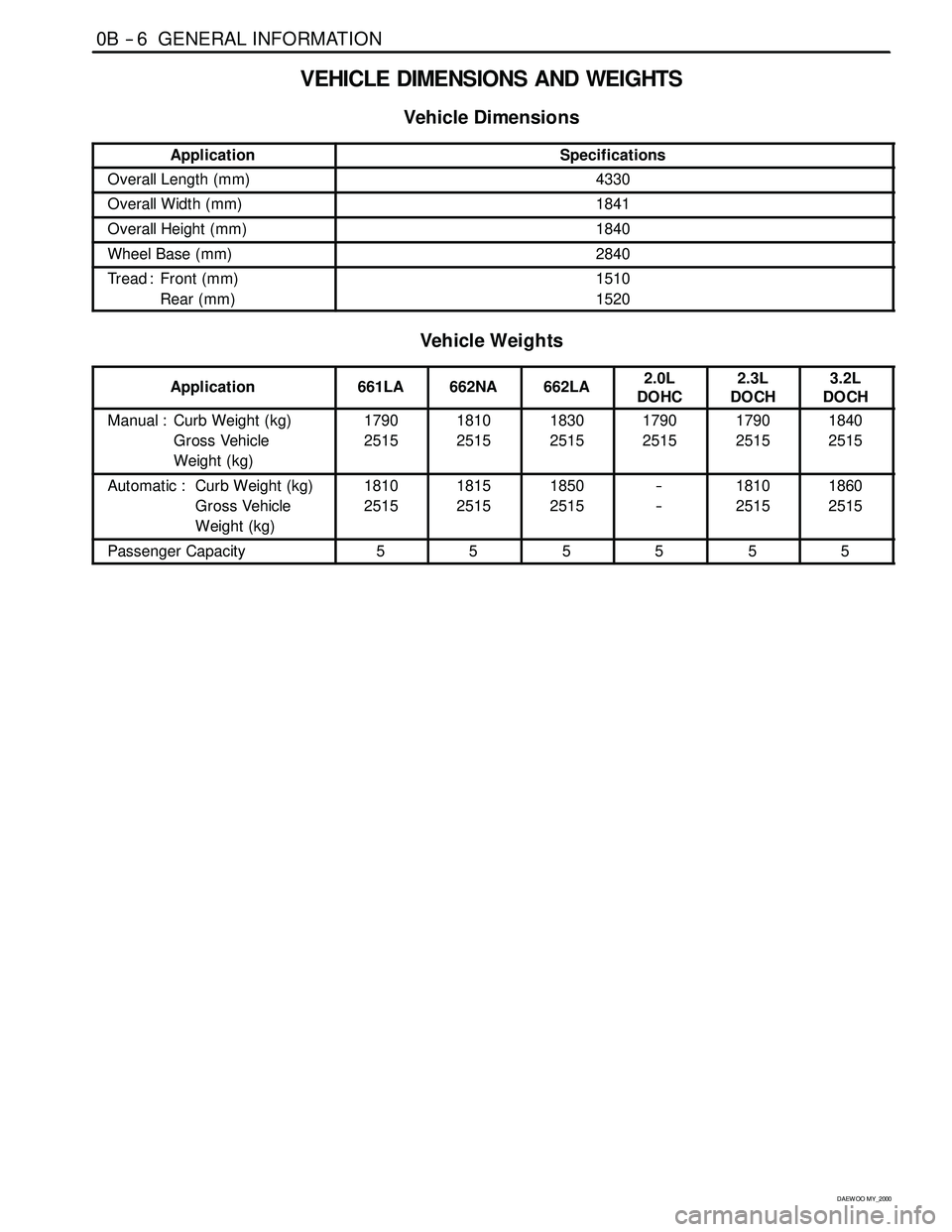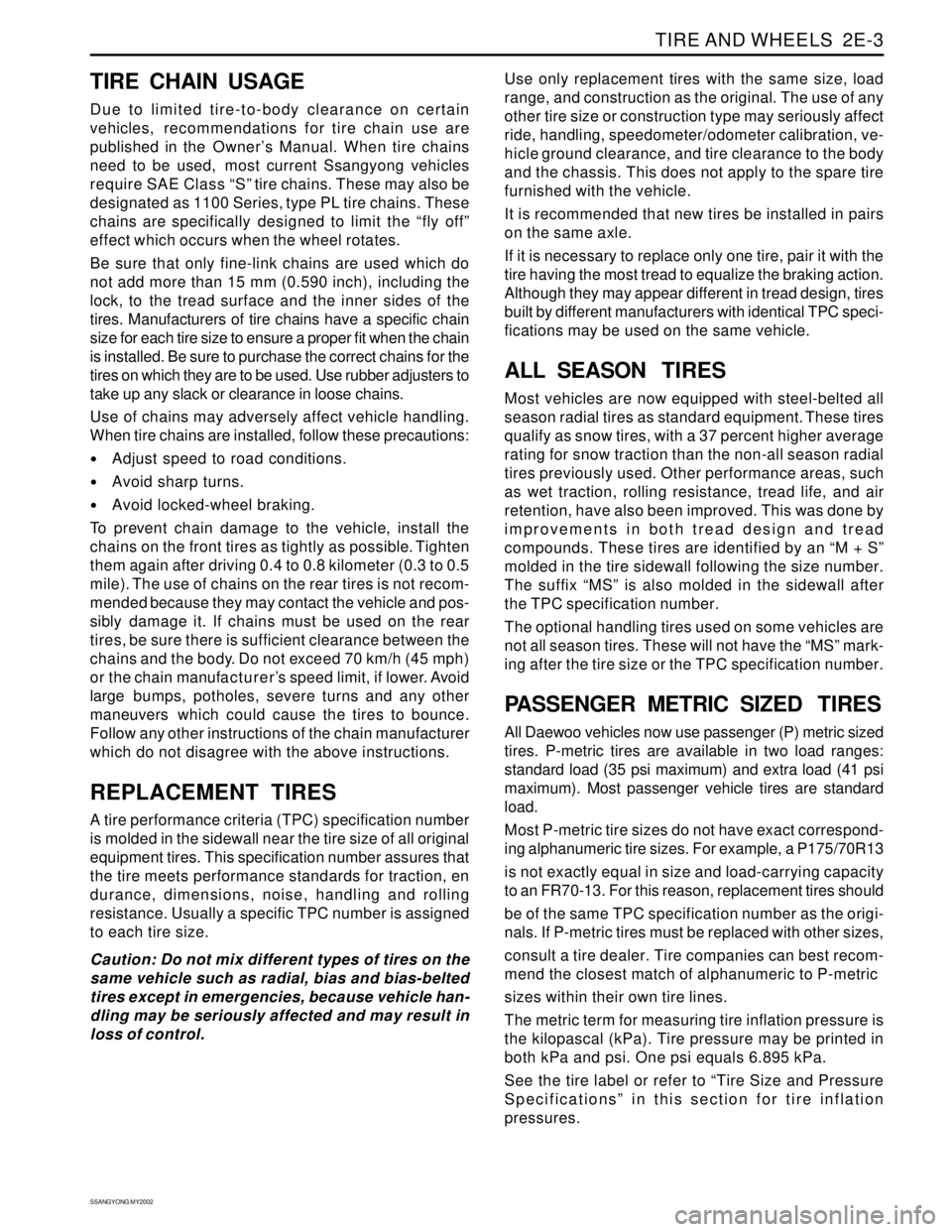dimensions SSANGYONG KORANDO 1997 Service Repair Manual
[x] Cancel search | Manufacturer: SSANGYONG, Model Year: 1997, Model line: KORANDO, Model: SSANGYONG KORANDO 1997Pages: 2053, PDF Size: 88.33 MB
Page 1 of 2053

D AEW OO M Y_2000
SECTION 0B
GENERAL INFORMATION
TABLE OF CONTENTS
Specifications 0B-- 2.............................
Technical Data 0B-- 2............................
Vehicle Dimensions and Weights 0B-- 6............
Standard Bolts Specifications 0B-- 7...............
Maintenance and Repair 0B-- 8....................
Maintenance and Lubrication 0B-- 8...............
Normal Vehicle Use 0B-- 8........................
Explanation of Scheduled Maintenance
Services 0B-- 8...............................
Scheduled Maintenance Charts
(Gasoline Engine) 0B-- 9.......................
Scheduled Maintenance Charts
(Diesel Engine) 0B-- 11.........................
Owner Inspections and Services 0B-- 13...........While Operating the Vehicle 0B-- 13...............
At Each Fuel Fill 0B-- 13..........................
At Least Twice A Month 0B-- 13...................
At Least Monthly 0B-- 13.........................
At Least Twice a Year 0B-- 13.....................
Each Time The Oil is Changed 0B-- 14.............
At Least Annually 0B-- 14.........................
Recommended Fluids and Lubricants 0B-- 15.......
General Description and System
Operation 0B--16................................
General Repair Instructions 0B-- 16................
Vehicle Identification Number System 0B-- 17.......
Vehicle Lifting Procedures 0B-- 20.................
Page 6 of 2053

0B -- 6 GENERAL INFORMATION
D AEW OO M Y_2000
VEHICLE DIMENSIONS AND WEIGHTS
Vehicle Dimensions
ApplicationSpecifications
Overall Length(mm)4330
Overall Width (mm)1841
Overall Height (mm)1840
Wheel Base(mm)2840
Tread : Front (mm)
Rear (mm)1510
1520
Vehicle Weights
Application661LA662NA662LA2.0L
DOHC2.3L
DOCH3.2L
DOCH
Manual : Curb Weight (kg)
Gross Vehicle
Weight (kg)1790
25151810
25151830
25151790
25151790
25151840
2515
Automatic : Curb Weight (kg)
Gross Vehicle
Weight (kg)1810
25151815
25151850
2515--
--1810
25151860
2515
Passenger Capacity555555
Page 713 of 2053

1B3 -- 164 OM600 ENGINE MECHANICAL
D AEW OO M Y_2000
Service Data
Piston clearanceMax. 0.12 mm
Piston crown protrusion in TDC position0.735 -- 0.965 mm
Connecting rod bushing diameter26.012 -- 26.018 mm
Connecting Rod Bolt Dimensions
ThreadM9 x 1
Stretch shaft(C) diameter (new)7.4-0.1mm
Minimum stretch shaft diameter (C)7.1 mm
Length(L)(new)52-0.3mm
Tools Required
000 589 04 14 00 Tensioning Strap
001 589 53 21 00 Dial Gauge
363 589 02 21 00 Dial Gauge Holder
Page 857 of 2053

TIRE AND WHEELS 2E-3
SSANGYONG MY2002
TIRE CHAIN USAGE
Due to limited tire-to-body clearance on certain
vehicles, recommendations for tire chain use are
published in the Owner’s Manual. When tire chains
need to be used, most current Ssangyong vehicles
require SAE Class “S” tire chains. These may also be
designated as 1100 Series, type PL tire chains. These
chains are specifically designed to limit the “fly off”
effect which occurs when the wheel rotates.
Be sure that only fine-link chains are used which do
not add more than 15 mm (0.590 inch), including the
lock, to the tread surface and the inner sides of the
tires. Manufacturers of tire chains have a specific chain
size for each tire size to ensure a proper fit when the chain
is installed. Be sure to purchase the correct chains for the
tires on which they are to be used. Use rubber adjusters to
take up any slack or clearance in loose chains.
Use of chains may adversely affect vehicle handling.
When tire chains are installed, follow these precautions:
Adjust speed to road conditions.
Avoid sharp turns.
Avoid locked-wheel braking.
To prevent chain damage to the vehicle, install the
chains on the front tires as tightly as possible. Tighten
them again after driving 0.4 to 0.8 kilometer (0.3 to 0.5
mile). The use of chains on the rear tires is not recom-
mended because they may contact the vehicle and pos-
sibly damage it. If chains must be used on the rear
tires, be sure there is sufficient clearance between the
chains and the body. Do not exceed 70 km/h (45 mph)
or the chain manufacturer’s speed limit, if lower. Avoid
large bumps, potholes, severe turns and any other
maneuvers which could cause the tires to bounce.
Follow any other instructions of the chain manufacturer
which do not disagree with the above instructions.
REPLACEMENT TIRES
A tire performance criteria (TPC) specification number
is molded in the sidewall near the tire size of all original
equipment tires. This specification number assures that
the tire meets performance standards for traction, en
durance, dimensions, noise, handling and rolling
resistance. Usually a specific TPC number is assigned
to each tire size.
Caution: Do not mix different types of tires on the
same vehicle such as radial, bias and bias-belted
tires except in emergencies, because vehicle han-
dling may be seriously affected and may result in
loss of control.Use only replacement tires with the same size, load
range, and construction as the original. The use of any
other tire size or construction type may seriously affect
ride, handling, speedometer/odometer calibration, ve-
hicle ground clearance, and tire clearance to the body
and the chassis. This does not apply to the spare tire
furnished with the vehicle.
It is recommended that new tires be installed in pairs
on the same axle.
If it is necessary to replace only one tire, pair it with the
tire having the most tread to equalize the braking action.
Although they may appear different in tread design, tires
built by different manufacturers with identical TPC speci-
fications may be used on the same vehicle.
ALL SEASON TIRES
Most vehicles are now equipped with steel-belted all
season radial tires as standard equipment. These tires
qualify as snow tires, with a 37 percent higher average
rating for snow traction than the non-all season radial
tires previously used. Other performance areas, such
as wet traction, rolling resistance, tread life, and air
retention, have also been improved. This was done by
improvements in both tread design and tread
compounds. These tires are identified by an “M + S”
molded in the tire sidewall following the size number.
The suffix “MS” is also molded in the sidewall after
the TPC specification number.
The optional handling tires used on some vehicles are
not all season tires. These will not have the “MS” mark-
ing after the tire size or the TPC specification number.
PASSENGER METRIC SIZED TIRES
All Daewoo vehicles now use passenger (P) metric sized
tires. P-metric tires are available in two load ranges:
standard load (35 psi maximum) and extra load (41 psi
maximum). Most passenger vehicle tires are standard
load.
Most P-metric tire sizes do not have exact correspond-
ing alphanumeric tire sizes. For example, a P175/70R13
is not exactly equal in size and load-carrying capacity
to an FR70-13. For this reason, replacement tires should
be of the same TPC specification number as the origi-
nals. If P-metric tires must be replaced with other sizes,
consult a tire dealer. Tire companies can best recom-
mend the closest match of alphanumeric to P-metric
sizes within their own tire lines.
The metric term for measuring tire inflation pressure is
the kilopascal (kPa). Tire pressure may be printed in
both kPa and psi. One psi equals 6.895 kPa.
See the tire label or refer to “Tire Size and Pressure
Specifications” in this section for tire inflation
pressures.
Page 1803 of 2053

SECTION 9N
FRAME AND UNDERBODY
TABLE OF CONTENTS
Specifications.......................................................9N-2
Fastener Tightening Specifications.......................9N-2
Underbody Dimensions.......................................9N-3
Maintenance and Repair.....................................9N-7
On-Vehicle Service.................................................9N-7
Alignment Checking............................................9N-7Floor Pan Insulators.............................................9N-7
Engine Under Covers ...........................................9N-8
General Description and System Operation........9N-9
General Body Construction..................................9N-9
Engine Under Covers ...........................................9N-9
Page 1805 of 2053

FRAME AND UNDERBODY 9N-3
SSANGYONG MY2002
UNDERBODY DIMENSIONS
KAA9N010
Page 1809 of 2053

FRAME AND UNDERBODY 9N-7
SSANGYONG MY2002
ON-VEHICLE SERVICE
ALIGNMENT CHECKING
An accurate method of determining the alignment of
the underbody uses a measuring tram gauge. The tram
gauge set used to perform the recommended
measuring checks must include a vertical pointer able
to reach 457 mm (18 inches).
Two types of measurements can be made with a tram
gauge: direct point-to-point measurements and
measurements calculated on a horizontal plane (datum
line) parallel to the underbody. Point-to-point
measurements are generally taken on steering and
suspension engine compartment parts and simply
require the vertical pointers to be set equally.
For horizontal plane measurements, the vertical pointers
must be set as specified for each point to be measured.
Dimensions-to-gauge holes are measured to the center
of the holes and flush to the adjacent surface metal
unless otherwise specified. It is recommended that
the diagonal dimensions to the cross-body be checked
on both sides in order to verify the dimensional
accuracy of the vehicle underbody.
FLOOR PAN INSULATORS
The floor pan insulators have been designed for the
higher floor pan temperatures that result from the use
of the catalytic converter in the exhaust system.
Therefore, when servicing a vehicle, it is essential that
any insulators that may have been disturbed or removed
be reinstalled in the original sequence and location.
Also, if an insulator needs to be replaced, use only
the insula-tion specified for that location on the floor
pan.
When servicing or replacing interior insulators, observe
the following instructions.
•Install the insulators in the original position and
sequence. Butt the pieces together in order to
avoid gapping or overlapping.
If it is necessary to replace an insulator, use only
the specified insulation.
Use the original part to determine the amount of
re-placement material required and as a template
for cutting and fitting the new piece to the floor
pan.
When installing the insulator, do not enlarge any
cut-outs or holes that are used for the attachment
of interior parts such as the instrument panel or
the floor console.
MAINTENANCE AND REPAIR